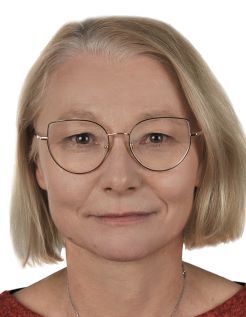Этот сайт использует куки.
Соответственно настройкам вашего браузера и для улучшения функционирования сайта umcs.pl были установлены куки. Используя этот сайт Вы соглашаетесь с их использованием. Вы можетеизменить это в настройках вашего браузера.
Semestr zimowy2023/2024
Dyżury stacjonarne(pokój 280B, Katedra Botaniki, Mykologii i Ekologii, Wydział Biologii i Biotechnologii UMCS):
wtorek: 10.30-12.00
środa: 11.00-12.00
Problematyka badawcza:
Publikacje naukowe w czasopismach znajdujących się w bazie Journal Citation Reports (JCR):
Czarnecka J., Kitowski I. 2013. Rook spring seed dispersal in the agricultural landscape: frugivory, granivory or accidental transport. Folia Geobotanica 48: 55-73.
Orłowski G., Czarnecka J. 2013. Re-evaluation of the role of the grey partridge Perdix perdix as a disperser of arable weed seeds. Journal of Ornithology 154 (1): 139-144.
Czarnecka J., Kitowski I., Sugier P., Mirski P., Krupiński D., Pitucha G. 2013. Seed dispersal in urban green space – Does the rook Corvus frugilegus L. contribute to urban flora homogenization? Urban Forestry and Urban Greening 12 (3): 359-366.
Czarnecka J., Kitowski I. 2013. The white stork as an engineering species and seed dispersal vector when nesting in Poland. Annales Botanici Fennici 50: 1-12.
Orłowski G., Karg J., Czarnecka J. 2013. Substantial contribution of invertebrates in the diet of winter seed-eater, the Reed Bunting Emberiza schoeniclus, wintering in a sewage farm in south-western Poland (Central Europe). Biological Journal of the Linnean Society 108 (2): 429-433.
Czarnecka J., Orłowski G., Karg J. 2012. Endozoochorous dispersal of alien and native plants by two palearctic avian frugivores with special emphasis on invasive American Goldenrod Solidago gigantea. Central European Journal of Biology 7 (5): 895-901.
Czarnecka J., Kitowski I. 2010. Seed dispersal by the Rook Corvus frugilegus L. in agricultural landscape – mechanisms and ecological importance. Polish Journal of Ecology 58 (3): 511-523.
Orłowski G., Karg J., Czarnecka J. 2010. Food of Water Pipit Anthus spinoletta on wintering grounds in south-western Poland. Bird Study 57 (3): 401-405.
Orłowski G., Karg J., Czarnecka J. 2011. Frugivory and size variation of animal prey in Black Redstart Phoenicurus ochruros during summer and autumn in south-western Poland. Ornis Fennica 88 (3): 161-171.
Orłowski G., Czarnecka J., Panek M. 2011. Autumn-winter diet of Grey Partridges Perdix perdix in winter crops, stubble fields and fallows. Bird Study 58 (4): 473-486.
Orłowski G., Czarnecka J. 2009. Granivory of birds and seed dispersal: viable seeds of Amaranthus retroflexus L. recovered from the droppings of the Grey Patridge Perdix perdix L. Polish Journal of Ecology 57 (1): 191-196.
Czarnecka J., Kitowski I. 2008. The potential role of nests of Black-billed Magpie Pica pica in accumulation and dispersal of seeds in agricultural landscape. Polish Journal of Ecology 56 (4): 673-682.
Czarnecka J. 2008. Spatial and temporal variability of seed bank resulting from overgrowing of xerothermic grassland. Acta Societatis Botanicorum Poloniae 77 (2): 157-166.
Orłowski G., Czarnecka J. 2007. Winter diet of reed bunting Emberiza schoeniclus in fallow and stubble fields. Agriculture Ecosystems and Environment 118: 244-248.
Czarnecka J. 2005. Seed dispersal effectiveness in three adjacent plant communities: xerothermic grassland, brushwood and woodland. Annales Botanici Fennici 42 (3): 161-171.
Czarnecka J. 2004. Microspatial structure of the seed bank of xerothermic grassland – intracommunity differentation. Acta Societatis Botanicorum Poloniae 73 (2): 155-164.
Czarnecka J. 2004. Seed longevity and recruitment of seedlings in xerothermic grassland. Polish Journal of Ecology 52 (4): 505-521.
Pozostałe artykuły naukowe:
Czarnecka J., Czarnecka B., Garbacz M. 2012. Secondary dispersal of seeds by Magpie Pica pica L. in agricultural landscape. Annales UMCS sec. C 67 (1): 13-25.
Czarnecka J. 2011. The role of linear structures in agricultural landscape in the maintenance of xerothermic species. Acta Agrobotanica 64 (4): 151-158.
Czarnecka J. 2011. Miedze jako siedliska gatunków muraw kserotermicznych w krajobrazie rolniczym Wołynia Zachodniego. Woda-Środowisko-Obszary Wiejskie 11 z. 2 (34): 43-54.
Czarnecka J. 2006. Roadsides as plant diversity refuges in agricultural landscape. Ecological Questions 7: 37-46.
Czarnecka J. 2004. Glebowy bank nasion – powstawanie i znaczenie w ekologii roślin. Edukacja Biologiczna i Środowiskowa. Kwartalnik dla Nauczycieli 4 (12): 5-11.
Czarnecka J. 2003. Regenerative strategies of Linum flavum and Brachypodium pinnatum and their consequences for regeneration of xerothermic grassland. Ecological Questions 3: 71-75.
Rozdziały w wydawnictwach zbiorowych:
Czarnecka, J. 2010. Spatial structure, soil bank and weeds' germination in a dynamic agricultural landscape of Western Wolhynia (south-eastern Poland). [w:] M. Barančoková, J. Krajčí, J. Kollár, I. Belčáková (red.). Landscape ecology – methods, applications and interdisciplinary approach. Institute of Landscape Ecology, Slovak Academy of Sciences, Bratislava, pp. 575-587.
Czarnecka J. 2009. The seed bank and the seed persistence of some weeds and grassland species from marginal habitats in arable landscape. [w:] Z. Mirek, A. Nikel (red.). Rare, relict and endangered plant species in Poland. W. Szafer Institute of Botany, Polish Academy of Sciences, Kraków, pp. 179-186.
Czarnecka J. 2004. Zachowanie i restytucja muraw kserotermicznych – znaczenie glebowego banku nasion. [w:] M. Kucharczyk (red.). Współczesne problemy ochrony krajobrazu. Zarząd Zespołu Lubelskich Parków Krajobrazowych, Lublin, pp. 291-295.
